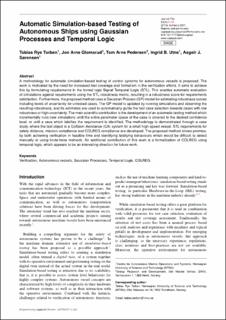Automatic simulation-based testing of autonomous ships using Gaussian processes and temporal logic
Peer reviewed, Journal article
Accepted version

Åpne
Permanent lenke
https://hdl.handle.net/11250/2989532Utgivelsesdato
2022Metadata
Vis full innførselSamlinger
- Institutt for marin teknikk [3429]
- Publikasjoner fra CRIStin - NTNU [37994]
Originalversjon
Proceedings of the Institution of Mechanical Engineers. Part O, Journal of risk and reliability. 2022, Januar 2022 . https://doi.org/10.1177/1748006X211069277Sammendrag
A methodology for automatic simulation-based testing of control systems for autonomous vessels is proposed. The work is motivated by the need for increased test coverage and formalism in the verification efforts. It aims to achieve this by formulating requirements in the formal logic Signal Temporal Logic (STL). This enables automatic evaluation of simulations against requirements using the STL robustness metric, resulting in a robustness score for requirements satisfaction. Furthermore, the proposed method uses a Gaussian Process (GP) model for estimating robustness scores including levels of uncertainty for untested cases. The GP model is updated by running simulations and observing the resulting robustness, and its estimates are used to automatically guide the test case selection toward cases with low robustness or high uncertainty. The main scientific contribution is the development of an automatic testing method which incrementally runs new simulations until the entire parameter space of the case is covered to the desired confidence level, or until a case which falsifies the requirement is identified. The methodology is demonstrated through a case study, where the test object is a Collision Avoidance (CA) system for a small high-speed vessel. STL requirements for safety distance, mission compliance, and COLREG compliance are developed. The proposed method shows promise, by both achieving verification in feasible time and identifying falsifying behaviors which would be difficult to detect manually or using brute-force methods. An additional contribution of this work is a formalization of COLREG using temporal logic, which appears to be an interesting direction for future work.